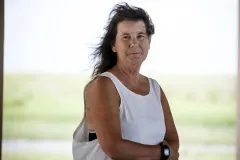Five Questions with Nancy Rabalais, Tracking Dead Zones In the Gulf

The Gulf of Mexico is known for one of the world's largest “dead zones"—areas of low- or no-oxygen water along the seafloor that suffocate most animal life. The average size of the Gulf's dead zone (also called a hypoxic zone) over the past 30 years is 5,300 square miles—about the size of Connecticut.
The Gulf's dead zone is caused primarily by agricultural fertilizer runoff that flows down the Mississippi River and into the sea. Just as nitrogen and phosphorus in fertilizers help crops grow, they also cause algae and phytoplankton to grow in excess at the surface of Gulf waters—a process known as eutrophication. Once they die, the algae sink to the seafloor, where their decomposition sucks up all the oxygen in the area. Fish and other animals can't breathe without oxygen, so they move away or die— which is how the “dead zone” gets its name.
Nancy Rabalais has studied the Gulf of Mexico dead zone since the 1980s. She also leads a team of scientists for the Gulf of Mexico Research Initiative—the Coastal Waters Consortium—looking at the impacts of the oil spill on coastal Gulf ecosystems. For her work on hypoxia, she received a MacArthur “genius” grant in 2012.
How did you become interested in coastal ecosystems and the interface between ocean and land?
I became interested in marine science when I took some courses in college that gave me the opportunity to learn a lot about organisms that lived in the coastal bays and habitats of south Texas. I was especially interested in identifying and classifying organisms, a branch of science called taxonomy. Those taxonomic skills were helpful in one of my first jobs—examining the mud-dwelling organisms across the South Texas continental shelf as a pre-assessment for oil and gas development. I also started scuba diving throughout the Gulf of Mexico, and I became very familiar with the many organisms of coastal habitats. I got to learn a lot about what was out there and under a variety of conditions and times of year.
For my PhD, I looked at the environmental physiology of an endemic South Texas fiddler crab that was different physiologically, morphologically, reproductively, behaviorally—it was completely different!—from other crabs in typical wetlands. Chasing fiddler crabs around south Texas, however, did not prepare me for the Congressional testimony I would give later in my life!
What are the most critical coastal issues right now?
I think the eutrophication issue is critical. I think habitat loss is critical. Dealing with sea level rise and the changing climate is critical. Those are some of the big ones.
Which of these coastal issues is still being affected by the Gulf oil spill, five years later?
The oil spill led to considerable marsh and shoreline erosion. As sea level rises, there will be more flooding and possibly more oil resuspension and movement as water flows through these coastal areas. You’re also going to have inundation of marshes and, if they are waterlogged for too long, they start to die off. With these losses, the natural processes that the ecosystems need to keep up with sea level changes are removed from the equation.
How were eutrophication and hypoxia—issues the Gulf has been facing for years—impacted by the oil spill?
We are still doing work to see if oxygen amounts in the Gulf were impacted by the oil spill. One area of interest is a well-known low-oxygen water layer at around 800 to 900 meters throughout the Gulf. This area is unusual because, although it is a hypoxic area, it has more oxygen than the typical man-made, shallow-water hypoxic areas we see directly off the coast. Some people hypothesized that the oil from Macondo would cause this low-oxygen area to be worse, but it was not much different from historical values. On the continental shelf we could still see oil remnants in July even after the well had been capped.
The typical shelf hypoxic zone 2010 data didn’t show anything different from what we saw in prior years or later years. We can’t definitively say that the oxygen numbers weren’t affected by the oil spill. But we can say that they were similar to every other year in the record—30 years or so. On the other hand, there seemed to be changes in the phytoplankton community in the surface waters of the Gulf in 2010 after the spill compared to years with similar river discharge and nutrient load.
Has the Gulf coast recovered from the Deepwater Horizon oil spill 5 years ago?
Some things look like they have not been affected. Some things have been affected. The oil continues to be there and will continue to be there for a longer time period than five years—more along the lines of decades. Many of the things that are being found now seem to be cumulative effects and indirect effects. Those are harder to put into the context of oil exposure.
Editor’s note: The research mentioned here related to oil impacts is funded by the Gulf of Mexico Research Initiative.The Ocean Portal receives support from the Gulf of Mexico Research Initiative (GoMRI) to develop and share stories about GoMRI and oil spill science. GoMRI is a 10-year independent research program established to study the effect, and the potential associated impact, of hydrocarbon releases on the environment and public health, as well as to develop improved spill mitigation, oil detection, characterization and remediation technologies. For more information, visit http://gulfresearchinitiative.org/.

